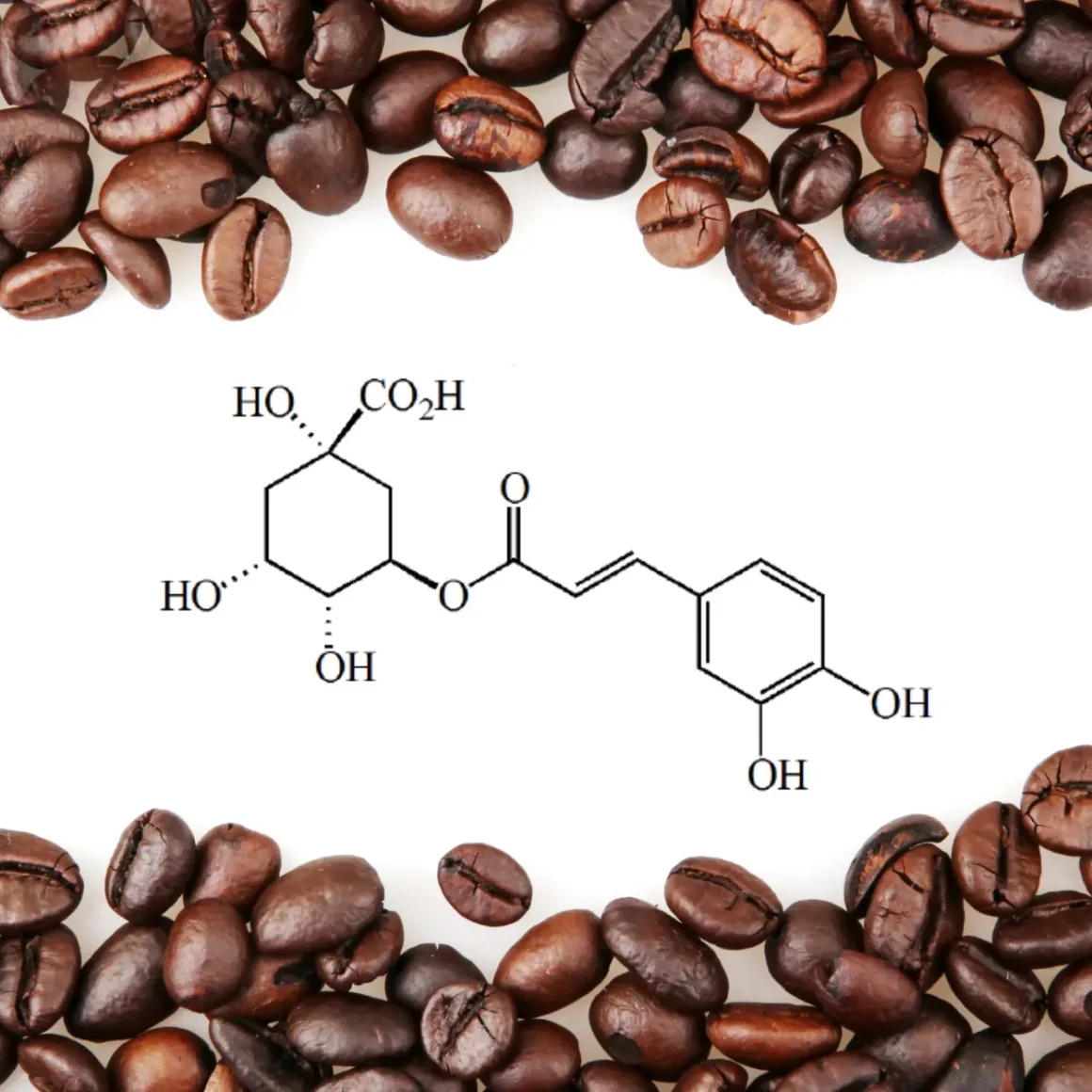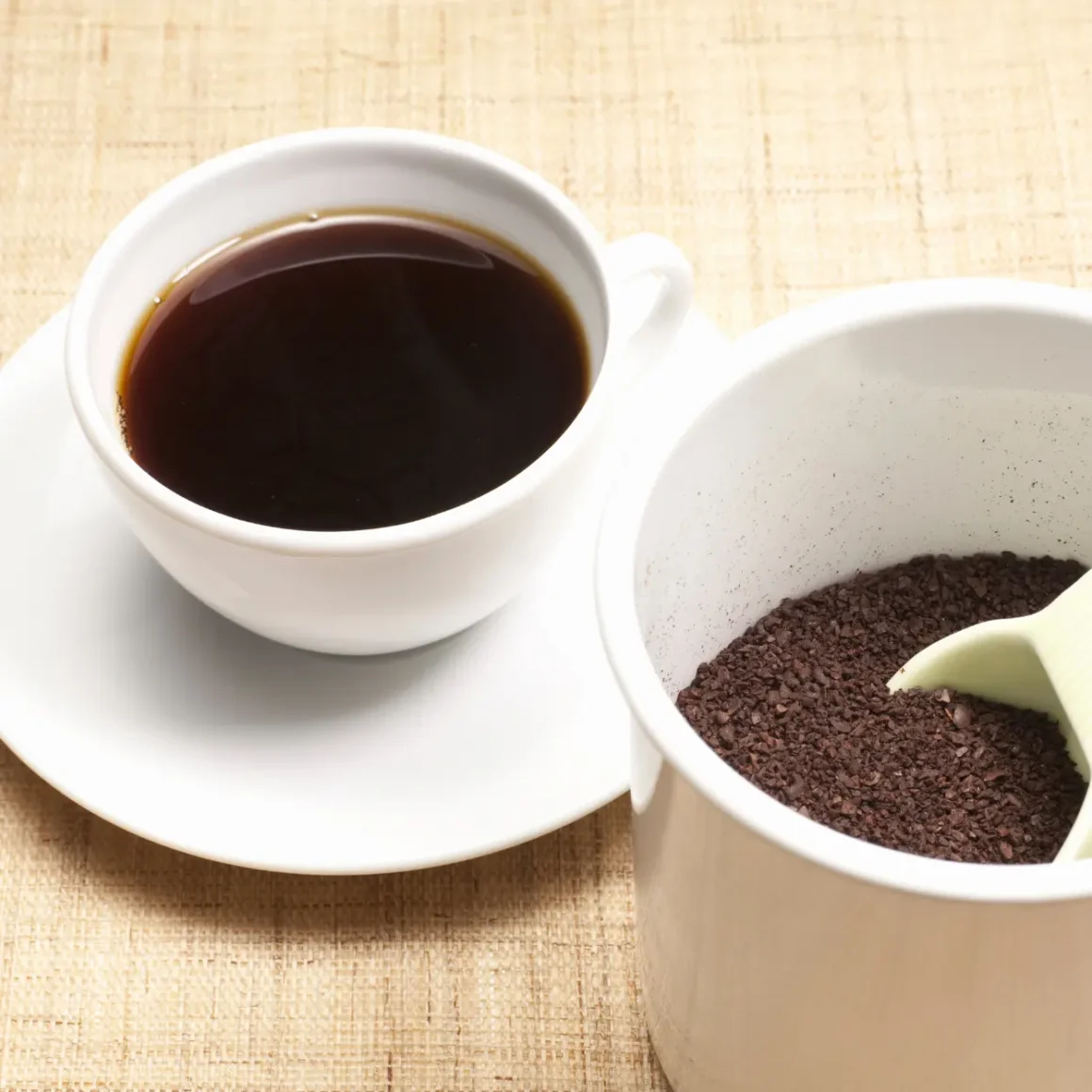Coffee, a beloved and widely consumed beverage, holds a secret beyond its captivating aroma and robust flavor – chlorogenic acid. While coffee enthusiasts savor the rich taste and stimulating effects, it’s the presence of this acid that has garnered significant attention in the world of health and nutrition. This natural compound found abundantly in coffee beans, has been a subject of scientific exploration, unveiling a range of potential health benefits. In this comprehensive exploration, we delve into the multifaceted world of chlorogenic acid in coffee, uncovering its origins, its antioxidant properties, effects on weight management and blood sugar regulation, and the art of brewing the perfect cup for maximum content of this acid. Join us on a journey to unravel the remarkable potential of CGA in coffee, a compound that goes beyond the brew to impact our well-being.
Give your eyes a break – click below to listen to the article.
- Introduction & Key Takeaway
- https://app.mysoundwise.com/tracks/17003836515225112e.mp3
- What Is Chlorogenic Acid?
- https://app.mysoundwise.com/tracks/17003836826926870e.mp3
- Health Benefits of Chlorogenic Acid
- https://app.mysoundwise.com/tracks/17003837211868022e.mp3
- Brewing the Perfect Cup for Maximum Chlorogenic Acid
- https://app.mysoundwise.com/tracks/17003837865068257e.mp3
- Historical and Cultural Significance
- https://app.mysoundwise.com/tracks/17003838502438462e.mp3
- Beyond Coffee: Other Sources of Chlorogenic Acid
- https://app.mysoundwise.com/tracks/17003838997383611e.mp3
- Conclusion & FAQs
- https://app.mysoundwise.com/tracks/17003839412154583e.mp3
Coffee & Chlorogenic Acid: Key Takeaway
- Chlorogenic Acid’s Health Benefits: This type of acid, found abundantly in coffee, offers numerous potential health benefits, including antioxidant properties that help combat free radicals, support weight management, and regulate blood sugar levels.
- Roasting Matters: The roast level of coffee beans significantly influences the content of this acid, with lighter roasts preserving more of this compound compared to darker roasts.
- Optimizing Your Brew: The extraction time, and temperature during coffee brewing also significantly impact CGA content in your cup, allowing you to tailor your coffee preparation to your preferences and health goals.
- Chlorogenic Acid Preservation: Careful cooking methods and temperature control are crucial for preserving this type of acid when preparing CGA-rich foods, ensuring you receive its potential health benefits.
- Beyond Coffee: While coffee is a well-known source of this type of acid, this beneficial compound can also be found in various fruits and vegetables, offering alternative dietary sources, and understanding how to preserve it during cooking can enhance its availability in your diet.
What Is Chlorogenic Acid?

Chlorogenic acid, also known as ‘CGA’, is characterized by its chemical structure, which includes a hydroxycinnamic acid group attached to a quinic acid moiety. This type of acid is most abundant in coffee beans, making it a key component of the beverage enjoyed by millions of people worldwide. It is one of the primary reasons coffee is often associated with certain health benefits. However, its effects can vary depending on factors such as the coffee bean variety and brewing method.
Coffee Beans: The Rich Source of Chlorogenic Acid
Coffee beans are renowned for their high concentration of this kind of acid, making them one of the richest dietary sources of this compound. Here are some key points about chlorogenic acid in coffee beans:
- Abundance: Coffee beans contain a wide range of CGA compounds (1), with their concentration varying depending on factors like the bean’s origin, processing method, and roast level.
- Role in Flavor: This acid contributes to the overall flavor profile of coffee, giving it the characteristic bitter and slightly astringent taste. However, it is important to note that the flavor can also be influenced by other compounds and factors such as brewing time and temperature.
- Health Benefits: Research suggests that chlorogenic acid in coffee may offer various health benefits, including antioxidant and anti-inflammatory properties. It may also play a role in regulating blood sugar levels and supporting weight management.
- Caffeine Content: Coffee contains caffeine, a stimulant that can have both positive and negative effects on health. While this type of acid contributes to coffee’s benefits, it’s essential to consider the potential impact of caffeine as well.
Varieties of Chlorogenic Acid Compounds
This kind of acid is not a single compound but rather a family of related compounds, each with its unique structure and potential health effects. Some notable varieties of chlorogenic acid in coffee beans include (2):
- Caffeoylquinic Acids: These compounds are the most prevalent form of CGA in coffee beans. They are known for their antioxidant properties and potential cardiovascular health benefits.
- Feruloylquinic Acids: This subset of this acid compound has gained attention for its potential anti-inflammatory effects and role in protecting cells from oxidative stress.
- Dicaffeoylquinic Acids: These compounds are less abundant but have been studied for their potential in preventing neurodegenerative diseases and supporting cognitive function.
To sum up, chlorogenic acid in coffee is a group of bioactive compounds with diverse properties and potential health benefits. The richness of this type of acid in coffee beans makes coffee a valuable dietary source of these compounds. However, the specific effects of CGA can vary depending on the coffee bean variety and preparation method, highlighting the importance of moderation and a balanced approach to coffee consumption for optimal health outcomes.
Health Benefits of Chlorogenic Acid
Chlorogenic acid, a prominent compound found in coffee, offers a range of potential health benefits due to its unique properties. Here, we explore some of the key advantages associated with this acid.
Antioxidant Properties and Free Radicals

Antioxidant properties of this acid involve its role in neutralizing free radicals, helping to combat oxidative stress and promote overall health.
- Antioxidant Power: CGA is well-known for its robust antioxidant properties. Antioxidants help combat free radicals in the body, which are unstable molecules that can damage cells and DNA. By neutralizing free radicals, this type of acid may reduce oxidative stress and prevent chronic diseases.
- Protection Against Age-Related Conditions: The antioxidant capacity of this acid suggests a potential role in protecting against age-related conditions such as cardiovascular disease, certain cancers, and neurodegenerative disorders like Alzheimer’s disease. These benefits are attributed to its ability to inhibit oxidative damage.
- Skin Health: Antioxidants, including CGA, are believed to have a positive impact on skin health. They may help reduce the signs of aging by protecting the skin from the harmful effects of UV radiation and environmental pollutants.
Potential Weight Management Effects

Chlorogenic acid in coffee has been studied for its potential weight management effects, including its impact on metabolism, fat absorption, and appetite regulation.
- Metabolic Boost: This kind of acid has been investigated for its potential to boost metabolism and aid in weight management. (3) Some studies suggest that it may help increase the rate at which the body burns calories, making it easier to achieve and maintain a healthy weight.
- Fat Absorption: There is evidence to suggest that this acid may inhibit the absorption of dietary fat in the digestive tract. This mechanism could contribute to weight loss efforts by reducing calorie intake from fat-rich foods.
- Appetite Regulation: This acid may also play a role in regulating appetite hormones. By influencing hormones like leptin, it can help control hunger and satiety, potentially reducing overeating and supporting weight loss.
Regulation of Blood Sugar Levels

Chlorogenic acid in coffee has shown potential in regulating blood sugar levels, particularly by improving insulin sensitivity and helping to stabilize glucose absorption
- Insulin Sensitivity: Some research indicates that this type of acid may improve insulin sensitivity. This means that it could enhance the body’s ability to use insulin effectively, which is crucial for regulating blood sugar levels. Improved insulin sensitivity may be particularly beneficial for individuals with type 2 diabetes or those at risk of developing the condition.
- Stabilizing Blood Glucose: This acid may help stabilize blood sugar levels by slowing down the absorption of glucose from the digestive tract. This effect can prevent rapid spikes and crashes in blood sugar, which are associated with feelings of fatigue and hunger. (4)
- Reduced Risk of Diabetes Complications: Maintaining stable blood sugar levels is essential in preventing long-term complications of diabetes, such as cardiovascular disease and nerve damage. This acid’s potential to regulate blood sugar may contribute to reducing these risks.
In summary, the chlorogenic acid in coffee offers a range of health benefits. Its antioxidant properties can help protect against oxidative stress and related diseases, while its potential effects on weight management and blood sugar regulation make it a promising compound for promoting overall health and well-being. However, it’s essential to note that individual responses to this type of acid may vary, and it should not be considered a standalone solution but rather part of a balanced and healthy lifestyle.
Brewing the Perfect Cup for Maximum Chlorogenic Acid
Achieving the perfect cup of coffee involves several factors, including the roast level of the beans, extraction time, and temperature. To harness the maximum content of this acid in your coffee, it’s essential to consider these elements and how they interact with each other.
Roasting Levels and Chlorogenic Acid Content

The roast level of coffee beans significantly influences the content of this type of acid.
- Light Roasting: Lightly roasted coffee beans retain more CGA compared to their darker counterparts. Light roasts preserve the chlorogenic acid content because they undergo less degradation during the roasting process. The flavors in light roasts are often brighter and more acidic, making them a favorable choice for those seeking higher levels of this acid in their brew.
- Medium Roasting: Medium roast coffee strikes a balance between flavor and chlorogenic acid content. These beans have a moderate roast level and offer a well-rounded taste profile while retaining a decent amount of CGA. Medium roasts are a popular choice for those looking for a flavorful yet moderately chlorogenic acid-rich cup of coffee.
- Dark Roasting: Darkly roasted coffee beans, on the other hand, have the lowest chlorogenic acid content. The extended roasting time and high temperatures break down CGA significantly, resulting in a rich, bold flavor but with diminished levels of this acid. Dark roasts are preferred by those who enjoy the deep, smoky notes but should be avoided by those specifically seeking this acid’s benefits.
Extraction Time and Temperature

The extraction time and temperature during coffee brewing are essential factors that impact the chlorogenic acid in coffee content.
- Extraction Time: The time coffee grounds are in contact with hot water influences this acid extraction. A longer extraction time typically results in less CGA content in the brewed coffee. Therefore, those aiming for higher levels of this type of acid should consider limiting their brewing time.
- Water Temperature: The temperature of the water used for brewing is crucial. While water that’s too hot can over-extract and degrade CGA, water that’s too cold may not effectively extract it. A range of 195°F to 205°F (90°C to 96°C) is generally recommended for optimal extraction of both flavor and chlorogenic acid.
In summary, achieving the perfect cup of coffee with maximum content of this type of acid involves a delicate balance between roast level, extraction time, and temperature. Light to medium roasts are favorable for preserving chlorogenic acid in coffee, but personal taste preferences should also be considered. It’s essential to experiment and find the combination that suits your palate while maximizing the potential health benefits of chlorogenic acid in coffee. Additionally, using a high-quality coffee roaster, if you roast your coffee beans at home, can further enhance your control over these variables.
Historical and Cultural Significance
Coffee, a beverage enjoyed by millions around the world, has a rich history steeped in tradition and cultural significance. In this exploration, we delve into the historical and cultural dimensions of coffee, uncovering the fascinating stories of its origins, its diverse rituals worldwide, and the role of CGA in traditional medicine.
The Origins of Coffee and Chlorogenic Acid Discovery

The origins of coffee can be traced back to the ancient coffee forests of Ethiopia, a discovery that was intimately linked with this type of acid.
- Coffee’s history is deeply intertwined with the discovery of CGA. The origins of coffee can be traced back to the ancient coffee forests of Ethiopia, where the coffee plant, Coffea arabica, is believed to have been first cultivated.
- Chlorogenic acid, although not identified by name at the time, played a pivotal role in coffee’s energizing effects. This natural compound contributed to the stimulating and invigorating properties of the beverage, making it a prized discovery.
Coffee Rituals Around the World

Coffee has transcended its place of origin and spread across the globe, becoming an integral part of numerous cultures and societies.
- Middle East: In countries like Turkey and the Middle East, coffee is traditionally prepared using finely ground beans and served in small cups with intense cardamom flavors. The process of preparing and serving coffee in this region is considered an art form, often accompanied by intricate ceremonies.
- Europe: European coffee culture is diverse, ranging from the strong and short espresso shots in Italy to the leisurely café culture in France. Coffeehouses have historically served as intellectual and social hubs, fostering discussions and gatherings.
- Asia: In countries like Japan, there is a strong emphasis on precision in coffee preparation. The pour-over brewing method, for instance, highlights the meticulous attention to detail in crafting the perfect cup of coffee.
- Latin America: Coffee is not only a significant export in countries like Colombia and Brazil but also an integral part of daily life. Coffee rituals often involve communal gatherings and celebrations.
Chlorogenic Acid in Traditional Medicine

Beyond its role in providing energy and enjoyment, CGA has found a place in traditional medicine practices in various cultures:
- Traditional Chinese Medicine: In traditional Chinese medicine, herbs and natural compounds have been used for centuries to promote health and balance in the body. Certain herbs containing this type of acid have been employed to address ailments related to digestion, circulation, and overall well-being.
- Indigenous Practices: In many indigenous cultures, plants and their natural compounds, including those containing CGA, have been used in healing rituals and remedies. These practices reflect the deep connection between nature and health.
Overall, the historical and cultural significance of coffee transcends mere consumption, weaving its rich tapestry into the fabric of societies across the world. From its origins in Ethiopia to the diverse coffee rituals practiced globally and its incorporation into traditional medicine, the chlorogenic acid in coffee has played multifaceted roles in human history and culture.
Beyond Coffee: Other Sources of Chlorogenic Acid
Coffee is often celebrated as a rich source of CGA, a natural compound known for its potential health benefits. However, the world of this acid extends far beyond the realm of coffee. Various fruits and vegetables also contain this valuable compound, providing alternative dietary sources. In this exploration, we delve into the diverse sources of this acid, from a wide array of fruits and vegetables to the considerations of this acid supplement. Additionally, we’ll discuss the importance of cooking methods in preserving this acid in food.
Fruits and Vegetables Rich in Chlorogenic Acid

Chlorogenic acid isn’t exclusive to coffee; it can also be found in various fruits and vegetables, offering alternative sources for those looking to incorporate this beneficial compound into their diet.
- Apples: Apples contain this type of acid, primarily concentrated in their peels. This compound contributes to the fruit’s antioxidant properties and potential health benefits.
- Berries: Blueberries, strawberries, and other berries are known for their CGA content. These antioxidants can contribute to the fruits’ protective effects against oxidative stress.
- Artichokes: Artichokes are a vegetable rich in this type of acid. They are not only a flavorful addition to dishes but also provide potential health benefits associated with this compound.
- Potatoes: CGA is found in both white and sweet potatoes. Roasting or baking potatoes can help preserve this compound.
- Tomatoes: Tomatoes are a versatile source of CGA. Cooking or processing tomatoes can increase the bioavailability of this compound.
Chlorogenic Acid Supplements: Yay or Nay?

While obtaining this type of acid from natural food sources is generally preferred, some individuals may consider supplements for convenience or specific health goals. Here are some considerations:
- Supplement Types: CGA supplements are available in various forms, such as capsules and powders. It’s essential to choose a reputable brand with transparent ingredient labeling.
- Dosage: The appropriate dosage of this acid supplements can vary depending on individual needs and health objectives. Consulting a healthcare professional is advisable to determine the right dosage.
- Safety: Supplements should be used with caution, as excessive intake may lead to side effects. It’s essential to be aware of potential interactions with medications and consult a healthcare provider if necessary.
Cooking and Chlorogenic Acid Preservation

When preparing chlorogenic acid-rich foods, the cooking process can impact the retention of this beneficial compound. Here are some tips for preserving this type of acid during cooking:
- Temperature Control: High temperatures can lead to CGA degradation. To minimize this, consider cooking at lower temperatures or using gentle cooking methods like steaming.
- Shorter Cooking Times: Reducing the cooking time can help retain more content of this type of acid. Opt for shorter cooking methods, such as blanching or stir-frying, when appropriate.
- Minimize Peeling: In fruits and vegetables where this kind of acid is concentrated in the peels or skins, consider leaving them intact whenever possible.
- Avoid Overprocessing: Excessive processing, such as canning or prolonged boiling, can lead to CGA loss. Opt for minimal processing to preserve this compound.
Overall, while coffee is a well-known source of this acid, it’s not the only one. Numerous fruits and vegetables also contain this beneficial compound, offering a variety of dietary options for those seeking its potential health benefits. Additionally, CGA supplements can be considered with caution, but natural food sources are generally preferred. When cooking chlorogenic acid-rich foods, careful attention to cooking methods and temperatures can help preserve this valuable compound, ensuring that you enjoy its potential advantages in your diet.
Conclusion
In conclusion, this exploration of chlorogenic acid in coffee has uncovered its historical, cultural, and health-related significance. It has shed light on this acid’s role as a potent antioxidant and its potential benefits for weight management and blood sugar regulation. The discussion has also touched upon the optimization of coffee brewing methods for maximizing this acid content and alternative dietary sources of this compound found in various fruits and vegetables. Ultimately, it encourages a balanced approach, recognizing that CGA enhances coffee’s appeal beyond its nutritional aspects, encompassing diverse flavors and cultural traditions.
FAQ
How does the roasting level affect the chlorogenic acid content in coffee beans?
The chlorogenic acid content in coffee beans decreases with darker roasts due to prolonged exposure to heat during the roasting process.
What is the historical significance of coffee and its chlorogenic acid content?
Coffee, with its CGA content, has a rich historical and cultural significance, originating in Ethiopia and spreading globally as a symbol of connection and conversation.
Are there other sources of chlorogenic acid besides coffee?
Yes, this acid can also be found in various fruits and vegetables, offering alternative dietary sources.
How does chlorogenic acid contribute to weight management?
This acid may impact weight management by influencing metabolism, fat absorption, and appetite regulation, potentially contributing to weight loss efforts.














